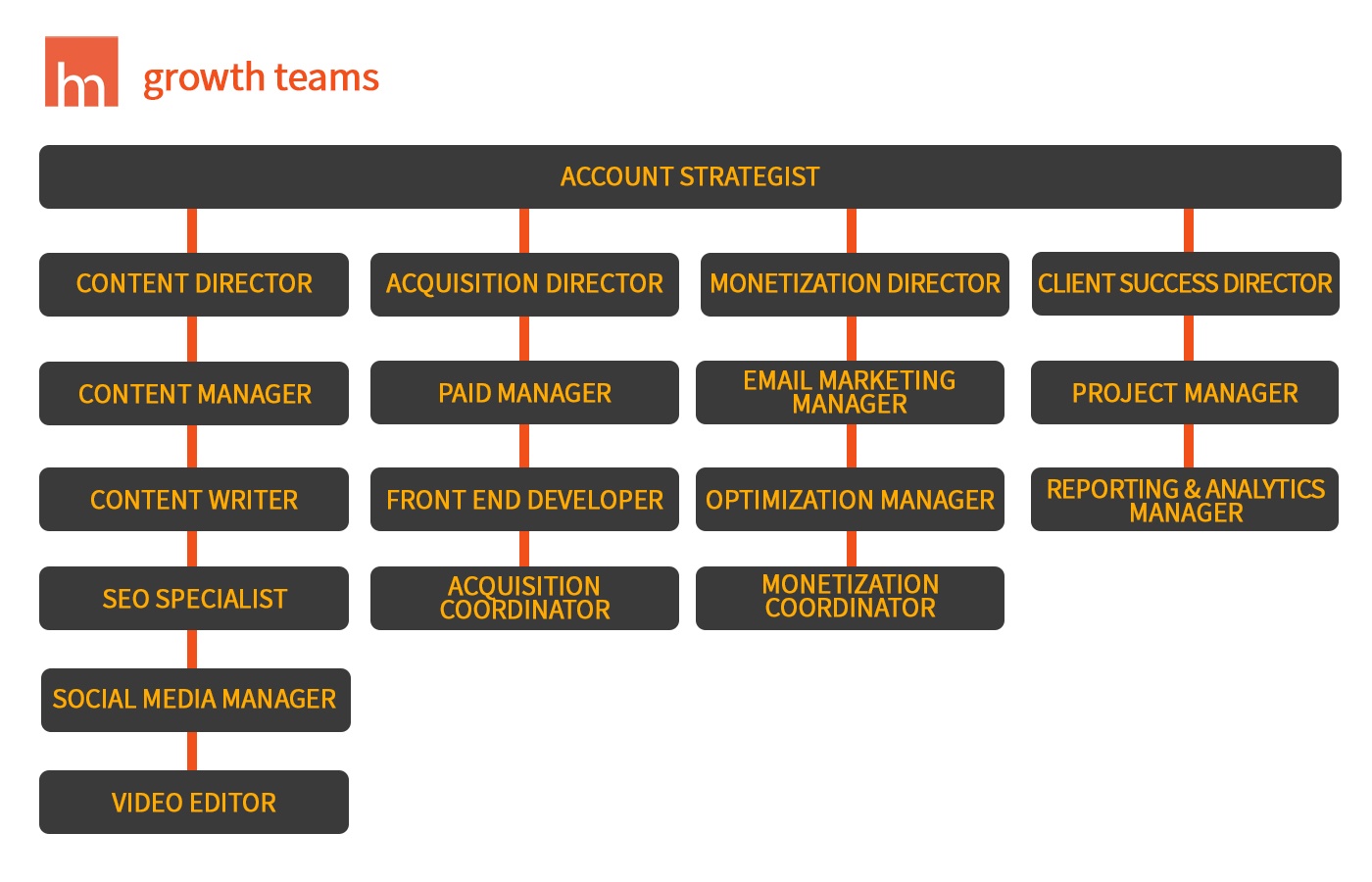As a fully outsourced digital marketing company, Human Marketing is growth-obsessed. We succeed when our clients do.
We also believe that company organization matters. When team members do what they love and feel valued, that passion translates into higher-quality work and results for clients.
So naturally, when we discovered the idea of growth teams at DigitalMarketer’s Traffic & Conversion Summit last year, we were hooked.

And in 2018, we’re introducing some sweeping departmental changes to specialize our teams and accelerate business growth for clients.
Introducing Growth Teams!
Growth teams is an organizational structure designed to focus marketing, sales and customer service units around growth, create accountability for key performance indicators and optimize the marketing funnel.
A growth team consists of four groups, each aligned with a phase of the customer journey: Content, Acquisition, Monetization and Success (CAMS).
Each unit is accountable for specific deliverables and metrics and relies on others to achieve success. The roles and KPIs of each team are clearly documented so everyone involved in the project knows what’s expected of CAMS and the metrics needed to achieve the client’s goals.
Here’s a breakdown of the CAMS responsibilities:
Content: Attract strangers into visitors through targeted blog posts, search engine optimization and consistent social media publishing.
Acquisition: Convert visitors into leads through compelling calls to action, landing pages, forms and content offers created by the content team.
Monetization: Close leads into customers through automated emails and nurturing and maximize all assets and leads generated from content and acquisition.
Success: Delight customers into promoters with value-add content, social engagement, surveys and superior client support.

Ecommerce Email Marketing Frequency: How Often Should You Email?
Why Shift From Marketing to Growth Teams?
As a results-driven digital marketing agency, instilling the growth mindset across our business just made sense. And above all, this structure aligned with our core values of going all-in with clients, learning and improving every day and tying every dollar to real business value.
The shift to growth teams has forced our agency to face some pretty tough questions, like:
- How do we structure our company to drive client goals?
- How do we break down cross-departmental barriers and create cohesion?
- How do we hold team members accountable to meaningful client metrics?
- How do we organize and manage projects?
- What does each employee actually do? And how do help them do more of what they love?
- What types of skills do we need to hire for?
Here’s how growth teams have helped us answer these questions and better serve clients:
Focus on Results Versus Deliverables
Labeling departments and job roles matters. Titles influence how employees perceive their job, responsibilities and the results expected from them.
Typical marketing teams are responsible for exactly that: marketing your product or service. Many agency retainers revolve around a series of marketing deliverables like weekly blog posts, paid, monthly newsletters, etc. Growth is a byproduct of these activities rather than the driver.
By shifting these structures to growth teams, the job scope and responsibilities shift from a deliverable (marketing) to a result (growth).
Unite Marketing, Sales and Support to Ease Discord
Traditional sales and marketing teams often clash. But to position a company for growth, sales and marketing have to work together.
By structuring marketing activities in terms of goals and KPIs, sales more clearly see and understand marketing-driven results and where their true responsibilities lay. Creating alignment streamlines the sales process, reduces friction and keeps everyone focused on growth (instead of bitter rivalries).
Align Metrics to Allow for Handoff, Not Conflict
Under the growth teams model, each unit is responsible for specific metrics related to a phase of the marketing funnel. These metrics enable the next team to perform their job responsibilities.
Here are some primary metrics each growth team is held to:
- Content: Organic visitors, bounce rate, scroll time, social growth
- Acquisition: Number of leads, click-through rate, cost per click, return on ad spend
- Monetization: Ecommerce conversion rate, revenue, cost of customer acquisition, customer lifetime value
- Success: Customer satisfaction score, net promoter score, customer stories, project management metrics
Aligning teams and KPIs with each phase of the marketing funnel (attract, convert, delight and close) creates a clearer picture of growth and isolates gaps in the funnel.
For example, the acquisition team needs traffic to convert leads, which it gets from the content team through blog posts and search engine optimization. And for the monetization group to generate revenue, they need leads — the primary metric the acquisition team is responsible for.
Each team relies on KPIs to decide what to do next.
Focus Job Responsibilities to Enable Specialization and Accountability
Within each CAMS team are specialized roles attached to KPIs that contribute to a company’s broader growth goals.

Fewer, more focused job responsibilities mean employees can concentrate on becoming experts in their craft, aggregate learnings and drive better results.
But to feel motivated and empowered, employees also need to understand how their role contributes to the bigger picture and fast-tracks their career path.
Implementing CAMS also involves creating detailed, KPI-driven job descriptions that serve as a visual ladder for growth. These help everyone understand their current job roles and responsibilities and how they support the growth engine.
Help Us Anticipate Hiring Needs
By documenting the roles, responsibilities, traits and success metrics for each job, we know exactly what to look for in new hires.
As an agency, there is inevitably employee crossover between growth teams and clients. By assigning people to specific roles, we can also see where the team is stretched thin and plan for new hires.
Adopting CAMS teams has been transformational for our agency. It’s the vehicle for KPI reporting, client strategy and growth. It centralizes reporting (email me for a sample KPI spreadsheet!), eliminates project clutter (aka tasks that don’t move the needle) and gives team members purpose.
In just a few months, the move has helped our agency better define who we are, what we do and the metrics that matter to a business.

Have questions about growth teams? Or want to learn how your company can benefit? Shoot me a line today.



